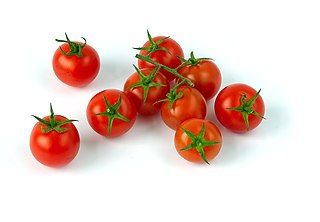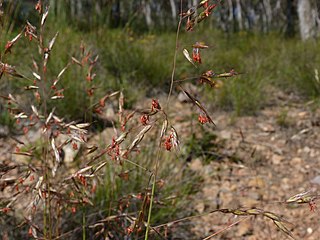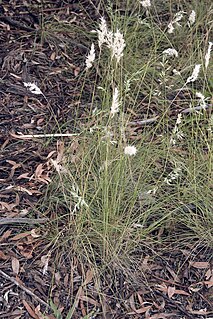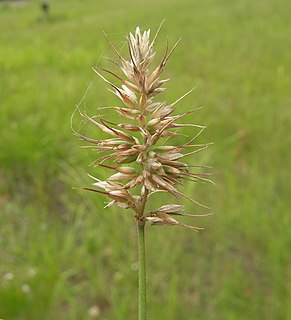
Maianthemum racemosum, the treacleberry, feathery false lily of the valley, false Solomon's seal, Solomon's plume or false spikenard, is a species of flowering plant native to North America. It is a common, widespread plant with numerous common names and synonyms, known from every US state except Hawaii, and from every Canadian province and territory, as well as from Mexico.

The cherry tomato is a type of small round tomato believed to be an intermediate genetic admixture between wild currant-type tomatoes and domesticated garden tomatoes. Cherry tomatoes range in size from a thumbtip up to the size of a golf ball, and can range from spherical to slightly oblong in shape. Although usually red, other colours such as yellow, green, purple, and black also exist. Those shaped like an oblong share characteristics with plum tomatoes and are known as grape tomatoes. The cherry tomato is regarded as a botanical variety of the cultivated berry, Solanum lycopersicum var. cerasiforme. In supermarkets, cherry tomatoes of different colors are often sold together with the phrase "mixed melody" in the name, indicating the great variance in their colors.

Desmodium is a genus in the flowering plant family Fabaceae, sometimes called tick-trefoil, tick clover, hitch hikers or beggar lice. There are dozens of species and the delimitation of the genus has shifted much over time.

Rytidosperma pallidum, commonly known as red-anther wallaby grass, is an Australian species of tussock grass found in Victoria, New South Wales and the Australian Capital Territory. The grass has flowers in December, and the flowers have a prominent red anther, after which it is commonly named.

Danthonia is a genus of Eurasian, North African, and American plants in the grass family. Members of this genus are sometimes referred to as oatgrass, but that common name is not restricted to this genus. Other common names include heathgrass and wallaby grass. Australian species have since been reclassified into the genus Rytidosperma.

Chionochloa is a genus of tussock grass in the family Poaceae, found primarily in New Zealand with one known species in New Guinea and another on Lord Howe Island. Some of the species are referred to as snowgrass.

Oplismenus is a small genus of annual or perennial grasses, commonly known as basketgrass, found throughout the tropics, subtropics, and in some cases, temperate regions of the Americas, Africa, Asia, and Australia. The systematics of the genus are unclear, with over 100 described species, only 7 species are officially recognized as of 2016.

Rytidosperma caespitosum, known by various common names including common wallaby-grass, ringed wallaby-grass, and white-top, is a species of grass native to southern parts of Australia.
Plinthanthesis is a genus of Australian plants in the grass family.

Rytidosperma is a genus of plants in the grass family. Most of the species occur in Australasia, with a few in insular Southeast Asia, southern South America, and certain islands of the Pacific. Several are known by the general common name wallaby grass.
Rytidosperma pumilum, also known as feldmark grass, is a species of grass in the family Poaceae. It is found in Australia and New Zealand.

Rytidosperma setaceum, known by various common names including small-flowered wallaby-grass, mulga- or bristly wallaby-grass, is a species of grass native to Australia. Originally described by Robert Brown under the name Danthonia setacea, it was transferred into Austrodanthonia by Hans Peter Linder in 1993 and finally Rytidosperma in 2011.

Teucrium racemosum, also commonly referred to as either the grey germander or forest germander, is a species of flowering plant in the family Lamiaceae. It is endemic to Australia and is found in all mainland states, the Northern Territory and the Australian Capital Territory. It grows in floodplains, dry lake beds and open woodlands. A perennial herb, it has four-sided, densely hairy stems, narrow egg-shaped leaves, and white flowers usually arranged singly in leaf axils. It grows to be between 15 and 40 cm tall.
Sphalmium is a monotypic genus of flowering plants in the protea family. The only species, Sphalmium racemosum, is a large forest tree. Common names include satin silky oak, mystery oak, Mt Lewis oak, poorman's fishtail oak and buff silky oak.
Rytidosperma unarede is a grass in the family Poaceae. The specific epithet is the Māori name unarede recorded by Raoul when the plant was first described in 1844.

Hakea francisiana, commonly called the emu tree, grass-leaf hakea or bottlebrush hakea, is a shrub or tree of the genus Hakea native to Western Australia and South Australia.

Echinopogon caespitosus, the bushy hedgehog grass or tufted hedgehog grass, is a species of grass native to southeastern Australia. It is often found in disturbed areas. The original specimen was collected at Katoomba railway station in 1931, and published in Icones Plantarum in 1934 by Charles Hubbard. The grass may grow to 1.5 metres, and is noticeable due to its dense, bristly head. The specific epithet is derived from Latin, meaning tufted.

Rytidosperma tenuius, or purplish wallaby grass, is an Australian species of wallaby grass found in south eastern Australia, usually on clay or sandy soils in the drier eucalyptus woodlands. The grass may grow up to 1.2 m tall. The spikelets have a purple tinged margins when old. The specific epithet tenuius is derived from the Latin for thin.

Rytidosperma bipartitum, the leafy wallaby grass, is a perennial species of grass found in south eastern Australia. Usually found on the heavier clay or on loamy soils in open eucalyptus woodland. The habit is somewhat variable, erect and densely tufted. The grass may grow up to 0.7 m tall.

Dendrobium racemosum, commonly known as the erect pencil orchid, is a species of orchid endemic to tropical North Queensland. It is an epiphytic or lithophytic orchid with yellowish stems, cylindrical dark green leaves and flowering stems with between eight and fifteen cream-coloured to pale yellow flowers with a thread-like tip on the labellum. It grows on trees and rocks in exposed positions in highland areas and in the tops of rainforest trees at lower altitudes.
















